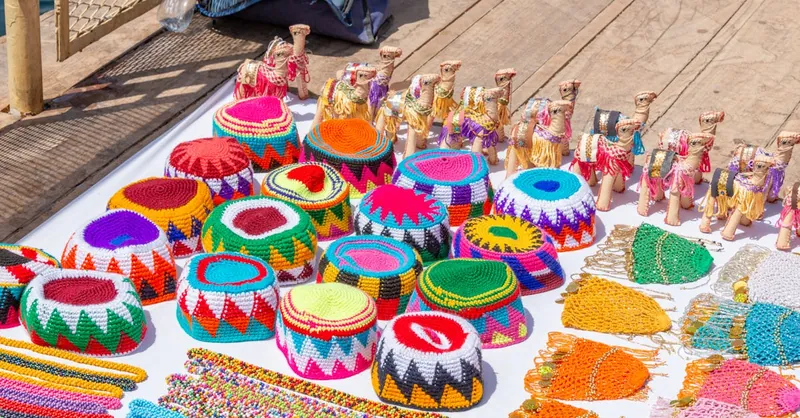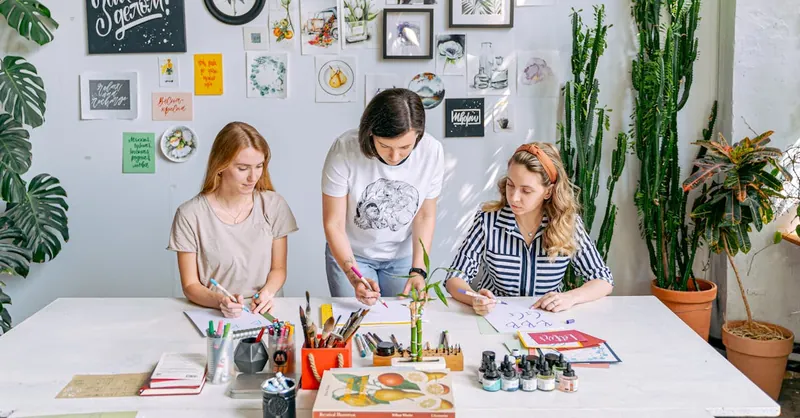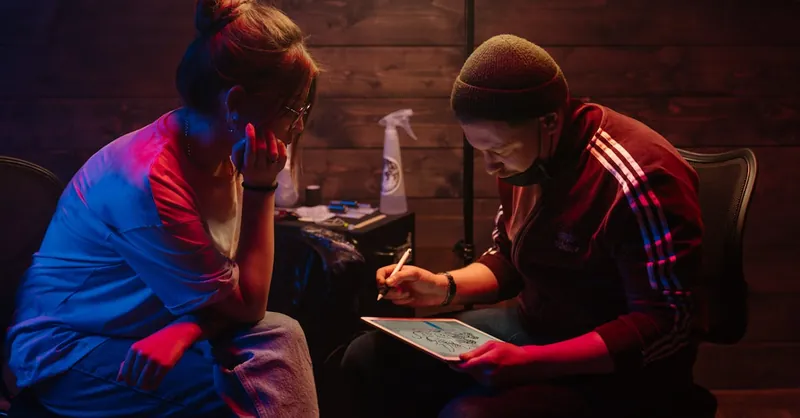Top Side Hustles for Creative People to Boost Income
Category: Side Hustles
Unlock Your Creative Potential with Flexible Side Hustles
Are you a creative individual looking for side hustles that fit around your busy schedule and let your artistic talents shine? Whether you're a designer, writer, artist, or craftsperson, finding the right way to monetize your creativity without sacrificing flexibility can be challenging. Maybe you've tried typical gig work and found it uninspiring, or you're searching for income streams that leverage your imagination and skill. This post is tailored just for you—the ambitious creative who wants more than a standard 9-to-5 paycheck but needs practicality and excitement combined.
We've scoured the internet and analyzed the top-performing resources on this subject to bring you a fresh, well-structured guide that goes beyond common advice. You'll discover innovative side hustles that suit varying skill levels, actionable tips to get started quickly, and insight into how to balance passion with profit. Our goal is to empower you to confidently pick a side hustle that not only boosts your income but also fuels your drive and growth on your own terms. Ready to explore creative ventures that pay off? Keep reading and uncover where your talents can take you financially.
- Unlock Your Creative Potential with Flexible Side Hustles
- Overview of Creative Side Hustles
- Popular Artistic Side Hustle Ideas
- Crafting and Handmade Goods: Turning Creativity into Profits
- Digital Content Creation: Opportunities for Creative Side Hustlers
- Teaching and Workshops: Share Your Creative Skills for Extra Income
- Custom Commissions and Freelance Projects: Navigating Client Work for Unique Creative Services
- Using Online Marketplaces & Platforms: Best Websites and Apps for Creative Gigs
- Balancing Creativity with Time Management: Strategies to Maintain Consistent Side Hustle Income Without Burnout
- Marketing Yourself as a Creative Entrepreneur: Tips for Branding, Networking, and Building an Online Presence
- Scaling Your Side Hustle: How to Evolve a Creative Side Gig into a Sustainable Business
Overview of Creative Side Hustles
A creative side hustle is any part-time venture that allows you to express your artistic talents while earning income on your own schedule. Unlike traditional jobs, these hustles prioritize flexibility and empower you to leverage skills such as design, writing, photography, crafting, or digital media creation. The core idea is transforming your creative passions into profitable opportunities without the constraints of fixed hours or rigid workplace demands.
Key characteristics of successful creative side hustles include:
- Monetizing original skills: Whether it's painting, graphic design, or content creation, turning your unique talents into marketable products or services.
- Flexible scheduling: Choosing projects and deadlines that fit around your lifestyle, making side hustling manageable alongside other commitments.
- Scalability: Starting small with manageable gigs and gradually building a sustainable income stream by enhancing your portfolio and client base.
- Diverse income streams: Combining multiple creative efforts, like selling prints online, freelancing, or teaching workshops, to maximize earning potential.
By embracing a creative side hustle, you not only generate extra money but also nurture your artistic growth while maintaining control over your time and aspirations. This balance of artistic fulfillment and financial gain is what makes creative side hustles especially rewarding for imaginative individuals seeking both freedom and profitability.

Image courtesy of Antoni Shkraba Studio
Popular Artistic Side Hustle Ideas
If you’re eager to put your creative skills to work and earn on your own terms, several artistic side hustles stand out for their accessibility, demand, and potential for profit. These popular options cater to a range of creative disciplines while offering the flexibility and growth opportunities vital for a sustainable side income.
1. Freelance Graphic Design
Freelance graphic design remains one of the most in-demand artistic side hustles, perfect for creatives proficient in digital tools like Adobe Illustrator, Photoshop, or Canva. You can offer services such as:
- Logo and brand identity creation
- Social media graphics and marketing materials
- Website UI/UX design
- Custom illustrations and infographics
Platforms like Upwork, Fiverr, and 99designs provide an easy entry point to find clients, build a portfolio, and set your own rates. Starting with small projects helps you develop your style and credibility, while recurring work or retainer clients provide steady income.
2. Photography and Photo Editing
Photography is a versatile side hustle that allows you to capitalize on your artistic eye. Whether specializing in portraits, events, product photography, or stock photos, you can monetize your work in multiple ways:
- Offering photography sessions for individuals, families, or businesses
- Selling images on stock photo websites like Shutterstock or Adobe Stock
- Providing photo retouching and editing services to other creatives or brands
This hustle benefits from flexible scheduling and scalable work volume—you choose when and how much to shoot and edit, making it ideal for balancing with other responsibilities.
3. Creative Writing and Content Creation
For the wordsmiths and storytellers, freelance writing opens doors to various fields such as blogging, copywriting, scriptwriting, or publishing ebooks. Demand is high for:
- Website content and blog posts tailored for SEO
- Marketing copy and social media captions
- Creative stories, poetry, and manuscripts
- Technical writing and product descriptions
Sites like ProBlogger, Freelancer, and Medium Partner Program allow writers to find gigs that complement their interests and strengths while setting flexible deadlines.
Embracing these artistic side hustles means you not only generate extra income but also deepen your expertise, expand your network, and sharpen your creative voice—all essential ingredients for long-term success as a creative entrepreneur. Whether you’re seeking to build a portfolio, grow a client base, or test new creative waters, these tried-and-true options offer proven pathways that blend passion with profit.

Image courtesy of Anna Nekrashevich
Crafting and Handmade Goods: Turning Creativity into Profits
For creatives who love working with their hands, crafting and handmade goods offer one of the most rewarding and flexible side hustles. Whether it’s jewelry making, knitting, woodworking, or personalized home decor, selling your unique handcrafted products enables you to showcase your artistic vision while generating income on your own schedule. Platforms like Etsy, Handmade at Amazon, and ArtFire provide accessible online marketplaces specifically designed for artisans, making it easier than ever to reach a global audience without needing a physical storefront.
Beyond online sales, tapping into local craft fairs, farmer’s markets, and pop-up shops can boost your visibility within your community and attract loyal customers who appreciate the personal touch and story behind your creations. Success in this side hustle hinges not only on creating high-quality, original items but also on mastering product photography, compelling storytelling, and effective marketing to stand out in a competitive marketplace. Some practical tips include:
- Niche down your craft to target a specific audience, such as eco-friendly products or custom pet accessories.
- Optimize product listings with SEO-friendly titles, detailed descriptions, and relevant keywords to enhance discoverability on platforms like Etsy.
- Leverage social media marketing, especially visually-driven platforms like Instagram and Pinterest, to showcase your work and connect with potential buyers.
- Offer customization or limited-edition items to create urgency and cater to customers seeking personalized experiences.
- Keep track of materials and labor costs to price your products competitively while ensuring profitability.
With dedication and smart strategies, crafting and selling handmade goods can evolve from a casual hobby into a scalable income source that flexes around your lifestyle, allowing you to fuel both your passion and your paycheck.

Image courtesy of Diego F. Parra
Digital Content Creation: Opportunities for Creative Side Hustlers
In today’s digital age, content creation offers a dynamic and scalable side hustle perfectly tailored for creatives who want to monetize their skills while controlling their schedule. Whether your passion lies in writing, video production, audio storytelling, or social media, digital platforms provide a vast landscape to share your unique voice and build a dedicated audience—all while generating income.
Blogging: Share Your Expertise and Build Authority
Blogging remains one of the most accessible creative side hustles for writers and thought leaders. By crafting engaging, valuable content on topics you’re passionate about—be it art, design, lifestyle, or niche hobbies—you can attract readers and monetize your blog through:
- Affiliate marketing: Earning commissions by recommending products and services.
- Sponsored posts and brand partnerships: Collaborating with companies to promote their offerings.
- Selling digital products: Offering ebooks, courses, or printable resources related to your expertise.
- Advertising revenue: Using platforms like Google AdSense to earn passive income from visitors.
Success in blogging relies on consistent content creation, SEO optimization for discoverability, and authentic engagement with your audience to build trust and grow your influence.
Vlogging and Video Content: Engage Through Visual Storytelling
If you thrive in front of the camera or enjoy video editing, vlogging on YouTube, TikTok, or Instagram Reels is a compelling way to showcase your creativity. Video content offers:
- Opportunities for ad revenue and sponsorships
- Selling merch or exclusive content through platforms like Patreon
- Building a personal brand that can lead to freelance gigs or consulting
To stand out, focus on niche content that reflects your creative strengths, whether that’s tutorials, behind-the-scenes glimpses, or entertaining storytelling. Consistency, authenticity, and engaging visuals are key drivers of growth.
Podcasting: Connect Through Voice and Storytelling
Podcasting is a rapidly growing medium perfect for creatives who enjoy deep conversations, storytelling, or sharing expert knowledge in an audio format. Monetization options include:
- Sponsorships and partnerships tailored to your audience
- Listener-supported fundraising via platforms like Patreon
- Cross-promotion of your other creative products or services
Podcasts allow intimate connection with your audience and build a loyal community while offering flexible production schedules ideal for busy creatives.
Social Media Influencing: Amplify Creativity and Monetize Impact
Social media platforms remain indispensable for creative side hustlers looking to build a personal brand and monetize their artistic lifestyle. By consistently sharing high-quality, original content through Instagram, Pinterest, TikTok, or LinkedIn, creatives can:
- Collaborate with brands on sponsored content
- Promote their own creative products or services
- Drive traffic to blogs, shops, or other digital platforms
Key to social media success is understanding your audience, creating visually compelling content, and utilizing platform-specific SEO tactics such as hashtags, keywords, and trends to increase reach and engagement.
By exploring these digital content creation avenues, creative individuals can develop diverse, flexible income streams that harness their passions and talents on their own terms. With the right strategy and consistent effort, blogging, vlogging, podcasting, and social media influencing can all unlock sustainable revenue while expanding your creative reach across the digital landscape.

Image courtesy of Mizuno K
Teaching and Workshops: Share Your Creative Skills for Extra Income
One of the most rewarding and flexible ways for creatives to monetize their talents is by teaching and hosting workshops—whether online or in person. As demand for skill-sharing grows, offering your expertise through online classes, tutoring, or creative workshops enables you to build a steady income stream while inspiring others. This side hustle works well for artists, designers, writers, musicians, photographers, and virtually any creative with a teachable skill.
Why Teaching Makes a Great Creative Side Hustle
- Flexibility: Design your teaching schedule around your availability, offering live sessions or prerecorded content.
- Scalability: Start with one-on-one tutoring, then expand to group workshops or sell courses on platforms.
- Passive income potential: Create evergreen courses that generate sales long after your initial effort.
- Authority building: Establish yourself as an expert, opening doors to more opportunities like speaking gigs or consulting.
How to Get Started with Teaching and Workshops
- Identify your teachable skill: Choose areas where you have both expertise and passion, such as watercolor techniques, digital illustration, creative writing, or photography editing.
- Choose a format: Decide between live virtual classes (via Zoom or Google Meet), prerecorded video tutorials, or hybrid models. For local creatives, in-person workshops at community centers or art studios are great options.
- Select the right platform: Online marketplaces like Udemy, Skillshare, Teachable, and Outschool offer built-in audiences and tools for course hosting. Alternatively, promote your own website or social media channels for personalized classes.
- Develop engaging content: Break down your skills into clear, actionable lessons. Use visuals, worksheets, and assignments to enhance learning and keep students motivated.
- Market your offerings: Leverage email newsletters, social media, and collaborations with creative communities to attract students. Highlight testimonials and showcase student work to build credibility.
- Set competitive pricing: Research similar courses and workshops to price your offerings attractively while valuing your time and expertise.
Leveraging your creativity to teach not only generates income but also enriches your own skill set through continual practice and feedback. Plus, it fosters meaningful connections within creative communities, amplifying your impact as both an artist and entrepreneur. Whether you prefer intimate tutoring or large-scale workshops, teaching can transform your creative passion into a profitable, schedule-friendly side hustle.

Image courtesy of Antoni Shkraba Studio
Custom Commissions and Freelance Projects: Navigating Client Work for Unique Creative Services
For creatives eager to leverage their skills in illustrations, logos, crafts, and other bespoke projects, custom commissions and freelance work offer an exciting, flexible side hustle with high earning potential. This path allows you to collaborate directly with clients who value your artistry and unique vision, turning personalized creative requests into profitable ventures on your own schedule.
How to Succeed with Custom Commissions and Freelance Creative Projects
-
Define Your Niche and Services Clearly
Specialize in areas such as custom illustrations, logo design, hand-crafted gifts, or bespoke artwork to attract clients searching for specific expertise. Being clear about your services, style, and deliverables helps set expectations and boosts client trust. -
Set Competitive and Transparent Pricing
Pricing bespoke projects can be complex. Consider factors like complexity, time investment, materials (for crafts), and usage rights. Offering tiered pricing packages or add-ons (e.g., expedited delivery or digital files) can cater to different client needs and increase sales. -
Build a Professional Portfolio and Website
Showcase your best commissioned work and client testimonials in a well-organized online portfolio. This not only highlights your skills but also serves as your primary marketing tool for attracting new clients via search engines and social media. -
Use Freelance Platforms and Marketplaces
Platforms like Fiverr, Upwork, and Behance are essential for finding initial clients and gaining reviews. For crafts and custom handmade items, marketplaces such as Etsy's custom order feature or ArtStation can connect you with buyers searching for unique commissions. -
Communicate Effectively and Set Clear Terms
Transparent communication about project scope, deadlines, revisions, and payment terms minimizes misunderstandings. Written contracts or agreements protect both you and your client, making the process professional and smooth. -
Manage Your Time and Workflow
Since custom projects often come with unique deadlines, use tools like Trello or Asana to track client requests, revisions, and delivery dates, ensuring you maintain flexibility without sacrificing quality or timely responses.
Benefits of Offering Custom Commissions and Freelance Creative Work
- Flexible Scheduling: Choose projects that fit your availability and workload, adapting to your lifestyle and priorities.
- Diverse Income Streams: Combine one-off commissions with recurring freelance contracts to stabilize your earnings.
- Creative Freedom: Customize work to match your artistic strengths while meeting client needs, fostering continuous growth.
- High Profit Margins: Personalized projects often command premium pricing due to their unique nature and direct client relationships.
By mastering the nuances of client collaboration and consistently delivering quality, creative professionals can transform custom commissions and freelance projects into highly rewarding, flexible side hustles that not only supplement income but expand professional networks and enhance reputations in the creative marketplace.

Image courtesy of cottonbro studio
Using Online Marketplaces & Platforms: Best Websites and Apps for Creative Gigs
Harnessing the power of online marketplaces and platforms is one of the smartest ways for creative people to find flexible side hustles that match their skills and schedules. These digital hubs connect creatives with clients looking for freelance design, writing, art, handcrafted products, teaching, and more. Understanding the pros and cons of each platform helps you select the best fit to maximize your income while preserving creative freedom.
Top Platforms for Creative Side Hustles
- Upwork
- Pros: Huge variety of job categories including graphic design, writing, and video editing; ability to build long-term client relationships; flexible pricing and project scope.
-
Cons: Competitive marketplace with bidding wars; fees can range from 5% to 20%; requires strong profile and portfolio to stand out.
-
Fiverr
- Pros: Ideal for quick, defined creative gigs (e.g., logo design, voiceovers, Photoshop edits); easy-to-navigate interface; straightforward pricing starting at $5; good for beginners.
-
Cons: Often low-paying at entry level; platform takes a 20% commission; scaling requires strategic gig optimization.
-
Etsy
- Pros: Best for selling handmade crafts, prints, and personalized art; built-in audience specifically seeking unique creative products; ability to customize shop and branding.
-
Cons: Listing fees and transaction fees apply; competitive niche demands SEO knowledge; marketing outside the platform is often necessary.
-
Skillshare & Udemy
- Pros: Great for creatives interested in teaching their craft; passive income potential with evergreen courses; platforms handle payments and hosting.
-
Cons: Revenue depends on student enrollment and platform promotions; upfront effort to create quality courses; significant course competition.
-
Behance & Dribbble
- Pros: Portfolio-focused platforms excellent for designers and illustrators; exposure to creative recruiters and agencies; opportunities for freelance projects.
-
Cons: Limited direct job bidding; mainly networking tools—requires proactive outreach; might need additional platforms to secure paid work.
-
Redbubble & Society6
- Pros: Print-on-demand sites that allow artists to sell their designs on merchandise without upfront costs; passive income from royalties; minimal logistical hassle.
- Cons: Lower royalty rates; heavy competition; less control over branding and customer experience.
Choosing the Right Platform for Your Creative Side Hustle
When selecting an online platform, consider these factors:
- Skill Compatibility: Does the platform cater specifically to your creative discipline? For example, Etsy excels for artisans, while Upwork is broad spectrum.
- Income Model: Are you looking for project-based payments, passive income, or recurring gigs? Platforms differ in how you earn and get paid.
- Fee Structure: Understand commissions, listing fees, or subscription costs that impact your net earnings.
- Audience and Traffic: Platforms with high user engagement can deliver better exposure but also face higher competition.
- Ease of Use: A user-friendly interface and robust support can save you time managing projects and clients.
By strategically leveraging these online marketplaces and platforms, creative side hustlers can gain valuable exposure, access diverse job opportunities, and build scalable income streams. Balancing multiple platforms to suit different facets of your creativity often yields the best financial and artistic results, enabling you to monetize your talents on your own terms while maintaining the flexibility essential to your creative lifestyle.

Image courtesy of Andrea Piacquadio
Balancing Creativity with Time Management: Strategies to Maintain Consistent Side Hustle Income Without Burnout
Successfully managing a creative side hustle requires more than just talent—it demands effective time management to sustain a consistent income while protecting your passion from burnout. Because creative work often thrives on inspiration rather than routine, striking a balance between output and rest is crucial for long-term success. Without intentional scheduling, many creatives risk overcommitting, leading to stress and diminished creative quality.
Key Strategies to Balance Creativity and Productivity
-
Set Realistic Goals and Prioritize Tasks
Clarify your income targets alongside creative milestones to focus on high-value projects. Use tools like the Eisenhower Matrix to separate urgent client deadlines from longer-term passion projects, ensuring you tackle what matters without feeling overwhelmed. -
Create a Flexible but Structured Schedule
Allocate dedicated time blocks for creative work, client communication, marketing, and personal rest. Scheduling “creative sprints” with breaks helps maintain mental freshness, while routine check-ins prevent procrastination and missed deadlines. -
Batch Similar Tasks
Grouping tasks such as responding to emails, editing, or social media posting reduces context switching, increasing efficiency. This batching approach frees more uninterrupted time for deep creative work. -
Set Clear Boundaries
Communicate your availability and turnaround times to clients upfront. Avoid taking on more projects than your capacity allows, and learn to say no to requests that don’t align with your goals or schedule. -
Utilize Productivity Tools
Leverage apps like Trello, Asana, or Notion to organize projects, track progress, and manage deadlines. These tools help visualize your workload, streamline communication, and prevent last-minute rushes that drain creative energy. -
Prioritize Self-Care and Creative Recharge
Regular breaks, physical activity, and hobbies outside of your hustle keep your mind sharp and inspiration flowing. Creativity is a renewable resource, but only when nurtured with adequate rest and mental space.
By mastering time management tailored to creative workflows, you can maintain consistent side hustle income without sacrificing the joy and originality that fuels your work. Remember, protecting your creative well-being is the foundation for sustainable productivity and financial growth in any artistic side hustle.

Image courtesy of Nataliya Vaitkevich
Marketing Yourself as a Creative Entrepreneur: Tips for Branding, Networking, and Building an Online Presence
To attract clients and grow your side hustle as a creative entrepreneur, mastering the art of marketing yourself is essential. Building a strong personal brand, expanding your network, and establishing a compelling online presence are key strategies that help you stand out in a competitive creative marketplace and generate consistent opportunities.
Craft a Unique Personal Brand
Your personal brand is the foundation of how potential clients perceive your creative services. Focus on developing a clear, authentic brand identity that reflects your style, values, and expertise. Consider these steps:
- Define your creative niche and target audience. Specializing helps you tailor messaging and showcase skills that resonate with clients looking for your particular talents.
- Develop a memorable visual identity. Consistent use of logos, color schemes, typography, and imagery across all platforms reinforces recognition and professionalism.
- Create a compelling brand story. Share why you create, what inspires you, and how your work delivers unique value to clients. This emotional connection can significantly boost client trust and loyalty.
Network Strategically to Build Meaningful Connections
Effective networking increases visibility and opens doors to new clients, collaborations, and referrals. For creative side hustlers, meaningful connections often translate directly to business growth. Some tips include:
- Join creative communities and forums both online (e.g., LinkedIn groups, Facebook creative circles) and offline (local art collectives or meetups).
- Attend industry events, workshops, and art fairs to meet potential clients and collaborators face-to-face.
- Engage authentically with peers and followers by commenting on their work and sharing helpful insights, which builds goodwill and reciprocal relationships.
- Leverage social media for networking by participating in relevant conversations, using hashtags strategically, and connecting directly with brands or clients.
Build and Optimize Your Online Presence
Your digital footprint is often the first point of contact for potential clients. Investing time in a professional, easily discoverable online presence boosts your credibility and attracts inquiries.
- Launch a dedicated website or portfolio that highlights your best work, client testimonials, service offerings, and contact information. A well-optimized site improves SEO, increasing your chances to appear in search results.
- Maintain active social media profiles tailored to your creative field. Platforms like Instagram, Pinterest, and LinkedIn are particularly effective for visual artists, designers, and writers. Use engaging posts, stories, and reels to showcase projects and share behind-the-scenes content.
- Implement SEO best practices by using relevant keywords in your website copy, portfolio descriptions, and blog posts to improve discoverability in search engines.
- Collect and display client reviews and case studies to demonstrate reliability and quality, encouraging new clients to trust your services.
By investing in strategic branding, purposeful networking, and a robust online presence, creative entrepreneurs can effectively market themselves, attract ideal clients, and build sustainable side hustles that thrive on their unique artistic talents. These marketing foundations create a powerful platform for ongoing growth and profitability on your own terms.

Image courtesy of RDNE Stock project
Scaling Your Side Hustle: How to Evolve a Creative Side Gig into a Sustainable Business
Once your creative side hustle starts gaining traction, the next exciting step is scaling your efforts to generate a sustainable income or even transition into full-time creative entrepreneurship. Successfully scaling requires smart planning, systemization, and a shift from a purely project-based approach to building long-term value and consistent revenue streams.
Strategies to Scale Your Creative Side Hustle
- Diversify Your Income Streams
To create financial stability and growth, expand beyond one-off projects or sales by incorporating multiple revenue channels such as: - Offering subscription-based products or services (e.g., monthly art prints or design templates)
- Launching online courses or memberships related to your creative expertise
- Partnering with brands for sponsorships or affiliate collaborations
-
Creating passive income through print-on-demand or digital downloads
-
Build a Strong Brand and Audience
Invest in growing a loyal community that trusts your work and comes back regularly. Engage your audience via email newsletters, social media, and exclusive content to nurture relationships that convert into repeat customers and referrals. -
Streamline Operations and Outsource Non-Core Tasks
Free up your creative energy by automating administrative processes such as invoicing, scheduling, and marketing. Consider outsourcing tasks like website management, customer service, or bookkeeping to focus on high-impact creative work. -
Raise Your Prices and Offer Premium Services
As your skill level and reputation increase, adjust your pricing to reflect your value. Introduce premium offerings such as custom commissions, consulting, or one-on-one coaching to enhance revenue and attract higher-end clients. -
Leverage Data and Feedback to Optimize Your Offerings
Use analytics from website traffic, sales data, and customer feedback to refine your products and services, tailoring them to market demand and improving customer satisfaction. -
Invest in Skill Development and Networking
Continuously improve your craft and business acumen by attending workshops, taking courses, and connecting with other creative entrepreneurs. This not only sharpens your offerings but opens doors to collaborations and new market opportunities.
Scaling a creative side hustle is less about working harder and more about working smarter—building systems that support growth, deepening client relationships, and evolving your creative brand into a sustainable business that aligns with your passion and lifestyle goals. By applying these strategies, you can confidently move from occasional gigs to a reliable income source that fuels both your creativity and financial independence.

Image courtesy of Kampus Production
